C70 L5-2.4L Turbo VIN 63 B5244T7 (2003)

Fault data and other information can be read off using the VIDA PC which is connected to the data link connector (DLC) under the center console cover
via VCT 2000. The VIDA PC communicates with the control module via a standardized interface.
Volvo on-board diagnostic (OBD) system
With the VIDA PC it is possible to:
-
read off and erase diagnostic trouble codes (DTCs) stored
-
activate components/functions according to predetermined patterns
-
Continuously monitor the value and status of input and output signals
-
carry out a self test on the system components.
-
read off control module identification.
To activate the Volvo on-board diagnostic (OBD) system:
-
ignition on
-
battery voltage normal.
Note! With the Volvo on board diagnostic system (OBD) activated the screen will always fold up, without showing any information. The RTI
system regains normal function when the diagnosis is finished!
Reading and erasing diagnostic trouble codes (DTCs)
Stored diagnostic trouble codes (DTCs) can be erased using this function. The on-board diagnostic (OBD) system can identify 11 different faults in the
form of diagnostic trouble codes (DTCs).
Diagnostic trouble codes (DTCs) can only be erased when all stored diagnostic trouble codes (DTCs) have been read off at least once.
Activating components/functions
Components and functions can be activated with this function. To activate components and functions the ignition must be on.
The following components can be activated:
-
display, color scale
-
sound, voice message function
Reading off input and output signals
Using this function the values and status of the control module input and output signals can be continuously read off.
